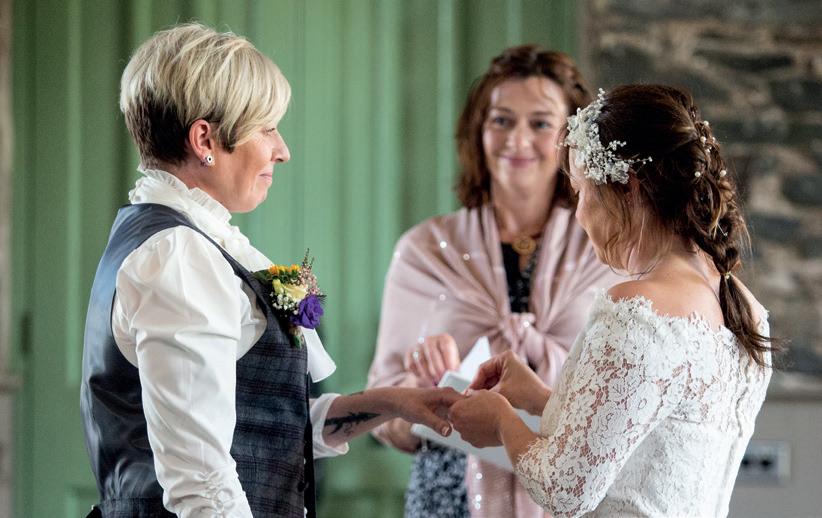
3 minute read
TWELVE WAYS TO REINVENT TRADITIONS FOR AN LGBTQ+ WEDDING
Curious about how to reinvent or reinterpret wedding traditions for your LGBTQ+ wedding? Here are 12 creative ideas
One
Advertisement
Who Proposes to Who in an LGBTQ+ Couple?
Traditionally, the groom asks the bride’s father for permission to propose, before going down on one knee and offering a ring. Who says it has to be like that? Not having the traditional script to follow, like it is the case of heteronormative weddings, can lead to confusion for some LGBTQ+ couples. Our number one tip is to listen to your partner, communicate so you make sure you don’t ruin their moment, or you don’t ruin theirs. If you’d like to ask, or would like to be asked, say it.
TWO
Don’t Be Confined by Wedding Party Labels
In an LGBTQ+ wedding (in fact, in any wedding!), gender shouldn’t define anyone’s role. The most important thing is having the people closest to you by your side. Just remember to share their duties with them. There might be a lot of stuff they need to help you with.
THREE
What Do You Wear to an LGBTQ+ Wedding?
If you’re the nearlyweds considering this, you can wear whatever you want! Most wedding traditions don’t necessarily make sense anymore, and dress code is one of them. What to wear on your wedding day is entirely up to you. No need for this suit or that dress. Be yourself and be comfortable.
Four
Who Walks Down the Aisle?
In a traditional ceremony, the bride is walked down the aisle and ‘given away’ by her father. Sounds rather outdated, right? But who says it has to be your father? Why not your best friend, a very close auntie or your mum? You could even walk down together if you want. It really is up to you! There are so many ways to make this moment your own.
Five
Where Do You Stand at an LGBTQ+ Wedding Ceremony?
The ancient wedding tradition of the bride and groom standing in certain places dates back to a time when grooms needed their right hand free to defend their bride from other suitors - but we’re hoping no sword fights break out at weddings these days...
Since you don’t need to follow the traditional male and female roles, stand on whichever side you feel most comfortable on. Discuss it beforehand so you don’t do an awkward little dance around each other at the altar.
Your attendants of honour can stand to the side of you, or take seats on the front row.
Six
Who Holds the Flowers at an LBGTQ+ Wedding?
The answer is, anyone! However you may identify, there’s no rule against one or both of you carrying bouquets, or getting rid of them altogether.
Seven
What About the Officiant?
The rules around marriage differ across the UK. Same sex marriage is legal across all >>>
...of the UK, and has been since March 2014 for Wales and England, December 2014 for Scotland and since 2020 in Northern Ireland, however the types of marriage ceremony available depends on the country you’re in.

Eight
What Symbolic Acts Can We Include?
The cultural assumptions that surround a wedding (taking the husband’s last name, the work of the wedding falling on the shoulders of the woman...) keep us stuck. Let’s keep pushing for progress, shall we?
How about including a symbolic act to represent your love and unity that your guests will remember forever?

Nine
Vows at an LGBTQ+ Wedding
Make your vows your own! At a civil or religious wedding ceremony, there are standard legal declarations and contracting words that you have to say. However, you can be creative too. Discuss your vows with your officiant first to find out what you’re allowed, what you can add in and what you can omit.
Ten
What About the Table Plan at an LGBTQ+
Wedding?
Traditionally, you’re meant to alternate between male and female guests when doing your seating plan - but those rules don’t apply here.
Leading British etiquette coach William Hanson says: “For same sex weddings the rule book can be adjusted or in some cases forgotten – so long as the wedding day itself is respectful, harmonious and civilised. The male-female seating plan is one traditional rule that obviously has to get abandoned as the newly married same sex couple will be seated next to each other on the ‘top’ table.”
Eleven
Who Gives a Speech at an LGBTQ+ Wedding? On to the speeches. Why not mix them up? Speeches are one area of a wedding where you don’t need to be bogged down by the rules, the only piece of advice to follow is to keep the toasts short (and funny!) for the benefit of your guests.

Twelve
Who Pays for What at an LGBTQ+ Wedding?
Traditionally, the bride’s parents would pay for the wedding, or at least a significant portion of it. Now, more and more couples are









